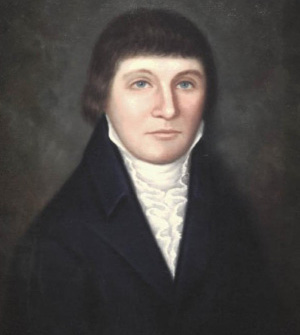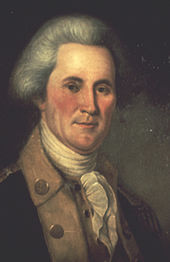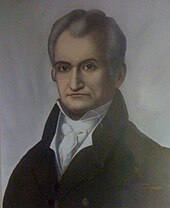
Richard Caswell was an American politician and lawyer who served as the first and fifth governor of the U.S. state of North Carolina from 1776 to 1780 and from 1785 to 1787. He also served as a senior officer of militia in the Southern theater of the American Revolutionary War. As a delegate to the First Continental Congress, he was a signatory of the 1774 Continental Association.

Thomas Blount was an American soldier, and politician. He served as a lieutenant in the North Carolina Line and as an adjutant general to Major General Richard Caswell in the North Carolina militia during the American Revolutionary War. After the war, he served as a representative in the North Carolina General Assembly and served three terms in U.S. representative from the 5th Congressional District in North Carolina.
The Hillsborough District Brigade of militia was an administrative division of the North Carolina militia established on May 4, 1776. Brigadier General Thomas Person was the first commander. Companies from the eight regiments of the brigade were engaged in 55 known battles and skirmishes in North Carolina, South Carolina, and Georgia during the American Revolutionary War. It was active until the end of the war.
The Salisbury District of North Carolina, was originally one of six colonial judicial districts established in 1766 by the Governor William Tryon of the Province of North Carolina. Immediately preceding the onset of the American War of Independence in 1775, these six regions were renamed "military districts" by the North Carolina Provincial Congress and used for organizing the North Carolina militia. The other military districts were Edenton, Halifax, Hillsborough, New Bern, and Wilmington districts. The military district designation was discontinued in 1835 during the North Carolina Constitution Convention.
Francis Locke Sr. (1722–1796) was a plantation owner, businessman, politician, and a participant in the American War of Independence, where he led the American Patriots to the decisive victory at Ramseur's Mill, which turned the tide of the American War for Independence in the south.
The Salisbury District Brigade was an administrative division of the North Carolina militia during the American Revolutionary War (1776–1783). This unit was established by the Fourth North Carolina Provincial Congress on May 4, 1776, and disbanded at the end of the war.
The Rowan County Regiment was originally established in about August 1, 1775 as a local militia in Rowan County in the Province of North Carolina. When the North Carolina Provincial Congress authorized thirty-five existing county militias to be organized on September 9, 1775, the Rowan County Regiment was included and all officers were appointed with commissions from the Provincial Congress. The members of the Rowan County Regiment were mostly from what was Rowan County at the time. Prior to establishment of the Rowan County Regiment, many of its officers were active in the Rowan County Committee of Safety. The regiment included 160 known companies and one or more of these companies were engaged in 36 known battles or skirmishes during the American Revolution. After the establishment of the Rowan County Regiment, several other counties were created from Rowan County, including Burke County in 1777, Iredell County in 1788, Davidson County in 1822 and Davie County in 1836.
The Anson County Regiment was authorized on September 9, 1775 by the Third North Carolina Provincial Congress. The regiment was engaged in battles and skirmishes against the British and Cherokee during the American Revolution in North Carolina, South Carolina and Georgia between 1776 and 1781. It was active until the end of the war.
The Surry County Regiment was established on August 26, 1775 by the North Carolina Provincial Congress. The regiment was engaged in battles and skirmishes against the British and Cherokee during the American Revolution in North Carolina, South Carolina Tennessee, and Georgia between 1776 and 1782. It was active until the end of the war.
The Wilkes County Regiment was authorized on December 9, 1777 by the Province of North Carolina Congress at the same time that Wilkes County, North Carolina was created from Surry County, North Carolina and Washington District, North Carolina. The regiment was subordinate to the Salisbury District Brigade of militia. It was engaged in battles and skirmishes against the British and Cherokee during the American Revolution in North Carolina, South Carolina, Tennessee, and Georgia between 1779 and 1782. It was active until the end of the war.
The Mecklenburg County Regiment was authorized on May 31, 1775 by the Province of North Carolina Congress. From November 7, 1779 until the 3rd Quarter of 1780, it was called the 1st Mecklenburg County Regiment when a 2nd Mecklenburg County Regiment existed. The 1st Mecklenburg County regiment was engaged in 39 known battles and skirmishes against the British during the American Revolution in North Carolina, South Carolina and Georgia between 1776 and 1781. It was active until the end of the war.
The Edenton District Brigade was an administrative division of the North Carolina militia during the American Revolutionary War (1776–1783). This unit was established by the North Carolina Provincial Congress on May 4, 1776, and disbanded at the end of the war.

The Halifax District Brigade was an administrative division of the North Carolina militia during the American Revolutionary War (1776–1783). This unit was established by the North Carolina Provincial Congress on May 4, 1776, and disbanded at the end of the war.
The Wilmington District Brigade was an administrative division of the North Carolina militia during the American Revolutionary War (1776–1783). This unit was established by the North Carolina Provincial Congress on May 4, 1776, and disbanded at the end of the war.
The New Bern District Brigade was an administrative division of the North Carolina militia during the American Revolutionary War (1776–1783). This unit was established by the North Carolina Provincial Congress on May 4, 1776, and disbanded at the end of the war.
The Morgan District Brigade was an administrative division of the North Carolina militia during the American Revolutionary War. This unit was established by the North Carolina Provincial Congress on May 17, 1782, and disbanded at the end of the war. The commander was Brigadier General Charles McDowell.
North Carolina state troops in the American Revolution were the initial military units created in a transition from the Province of North Carolina under British rule to independence from British rule. Most units did not last long as such and were either transferred to the Continental Army or state militia instead.
The Dobbs County Regiment was a unit of the North Carolina militia that served during the American Revolution. The regiment was one of thirty-five existing county militias that were authorized by the North Carolina Provincial Congress to be organized on September 9, 1775. All officers were appointed with commissions from the Provincial Congress. On May 4, 1776, the regiment was placed under the command of the New Bern District Brigade commanded by Brigadier General Richard Caswell. The regiment was active until the end of the Revolutionary War in 1783 and was engaged in twelve known battles and skirmishes in North Carolina, South Carolina and Georgia.
The Wayne County Regiment was a unit of the North Carolina militia that served during the American Revolution. The North Carolina General Assembly created Wayne County and its regiment of militia out of part of Dobbs County and its regiment of militia on November 2, 1779. The officers were appointed and commissioned by the governor of North Carolina. The regiment was disbanded at the end of the war.















